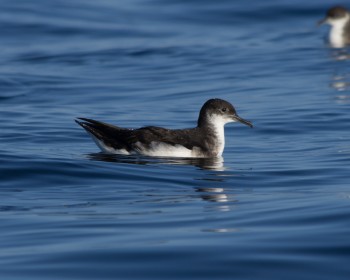Maíra Duarte Cardoso (Programa de Pós-Graduação em Saúde Pública e Meio Ambiente, Rio de Janeiro, Brazil) and colleagues have studied pollutants in the Manx shearwater Puffinus puffinus, publishing open access in the on-line journal Aquatic Biosystems.
The paper’s abstract follows:
Introduction: Seabirds have been historically used to monitor environmental contamination. The aim of the present study was to test the suitability of a species belonging to the Procellariiformes group, the Manx shearwater, Puffinus puffinus, as a sentinel of environmental health, by determining contaminant levels (trace metals and organochlorine compounds) from carcass tissues and by isolating Vibrio spp. and Aeromonas spp. from live specimens. To this end, 35 Puffinus puffinus carcasses wrecked on the north-central coast of the state of Rio de Janeiro, Brazil, and two carcasses recovered in Aracruz, on the coast of the state of Espírito Santo, Brazil, were sampled, and fragments of muscle and hepatic tissues were collected for contaminant analyses. Swabs from eleven birds found alive at the north-central coast of Rio de Janeiro were collected for isolation of the aforementioned bacteria.
Results: The average concentration in dry weight (dw) of the trace metals were: mercury 7.19 mg kg−1 (liver) and 1.23 mg kg−1 (muscle); selenium 34.66 mg kg−1 (liver) and 7.98 mg kg−1 (muscle); cadmium 22.33 mg kg−1 (liver) and 1.11 mg kg−1 (muscle); and lead, 0.1 mg kg–1 (liver) and 0.16 mg kg−1 (muscle). Organochlorine compounds were detected in all specimens, and hexachlorbiphenyls, heptachlorbiphenyls and DDTs presented the highest levels. Regarding microbiological contamination, bacteria from the Vibrio genus were isolated from 91% of the analyzed specimens. Vibrio harveyi was the predominant species. Bacteria from the Aeromonas genus were isolated from 18% of the specimens. Aeromonas sobria was the only identified species.
Conclusions: The results indicate that Puffinus puffinus seems to be a competent ocean health sentinel. Therefore, the monitoring of contaminant levels and the isolation of public health interest bacteria should proceed in order to consolidate this species importance as a sentinel.”

Manx Shearwater, photograph by Nathan Fletcher
Reference:
Duarte Cardoso, M., Fulgencio de Moura, J., Tavares, D.C., Gonçalves, R.A., Colabuono, F.I., Roges, E.M, Laine de Souza, R., Dos Prazeres Rodrigues, D., Montone, R.C. & Siciliano, S. 2014. The Manx shearwater (Puffinus puffinus) as a candidate sentinel of Atlantic Ocean health. Aquatic Biosystems 2014, 10:6. http://www.aquaticbiosystems.org/content/10/1/6.
John Cooper, ACAP Information Officer, 17 October 2014

 English
English  Français
Français  Español
Español